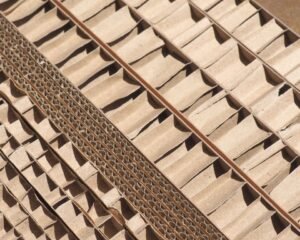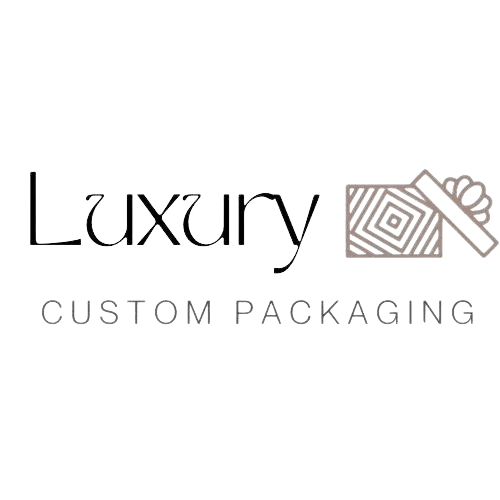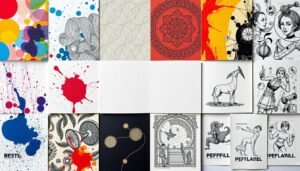Corrugated packaging is the most commonly reused material in the world. Over the past eight years, its recovery rate has stood at about 90%. And in 2018, that number shot up to an impressive 96%. This type of packaging is not just good for the planet. It’s also changed the game for how companies keep their goods safe and move them around.

These boxes are tough and protect items well. They are made up of layers of paper. There’s an inside part, an outside part, and a wavy bit in the middle. Sticky glue holds it all together. Thanks to this setup, the boxes are strong but not heavy. They can take a beating from drops, water, and big swings in temperature.
The boom in online shopping has driven up need for these boxes. In 2018, almost 1.9 billion people picked up something online. And by 2021, this number is forecast to hit 2.14 billion. This means companies are looking for packaging that can do more. They want it to keep goods safe and make customers smile when they open their package.
There are many advantages to choosing corrugated boxes. For one, they are light. This cuts down on shipping costs. They also can be made to fit a company’s unique style. And the cherry on top: they’re easy to recycle. This makes them a top pick for sending things out, showing off products, or keeping food fresh for online food sellers. It’s a win-win for both the business and the planet.
Understanding the Basics of Corrugated Packaging
Learning about corrugated packaging starts with its key parts. These are linerboard, medium, and flutes. The linerboard acts as the outer and inner layers of the board. The medium is the paper that runs in between, formed into arches and glued to the linerboard.
The Components of Corrugated Packaging
Linerboard comes in different weights, from 115/125 gsm to 300 gsm. It can be various grades like Chip (C) or Kraft (K). The medium, creating the flutes, varies in size and shape, each with its own strengths.
Different Types of Corrugated Board
Corrugated board types include single-face, single-wall, double-wall, and triple-wall. Single-face board has one medium attached to one linerboard. Single-wall board, known for its common use, has a medium between two liner boards. Double-wall has more layers for added strength, and triple-wall is even stronger for heavier items.

Flute Profiles and Their Characteristics
There are various flute profiles, like A, B, C, E, and F, each with unique features. The common flutes are A, B, C, E, and F. A and C flutes are thick and offer good cushioning. E and F flutes are thin and great for showing off graphics.
| Flute Profile | Thickness (mm) | Flutes per Foot | Characteristics |
|---|---|---|---|
| A | 5 | 33 | Cushioning, stacking strength |
| B | 3.2 | 47 | Die-cut designs |
| C | 4 | 38 | Widely used |
| E | 1.6 | 90 | Retail packaging, printability |
| F | 0.8 | 125 | Clear image quality |
Other flute types, like BC and EB, offer a mix of benefits. Choosing the right flute is crucial. It depends on what the packaged item needs, such as cushioning or a nice print.
With this knowledge, businesses can pick the best packaging for their goods. It helps to keep products safe, look good, and please customers.
Corrugated Packaging vs. Cardboard: Key Differences
Understanding the difference between corrugated packaging and cardboard boxes is crucial. They are both often used for shipping but vary in key ways.

Materials Used in Construction
Corrugated packaging and cardboard differ in materials. Cardboard boxes use thick paper or pulp, which is lightweight. Conversely, corrugated boxes have an inside liner, outside liner, and a fluted medium in between. This setup grants them great strength.
Durability and Strength
The durability of corrugated packaging surpasses that of cardboard. With its three-layer design, corrugated cartons endure shocks, moisture, and temperature changes better. This keeps contents secure and dry during handling and transit. Cardboard is less robust due to its single-layer structure, offering minimal protection.
Applications and Uses
Due to the materials and durability differences, each type of packaging is suited for different tasks. Cardboard boxes work well for shipping light items, like clothes, efficiently. They also aid in keeping these items neatly packed.
Corrugated packaging is best for heavier items, retail displays, and mailing food, like pizza. Its various customization options, including thickness, size, and design, meet specific product and brand needs. Companies offering subscriptions often use custom corrugated packages with special support to protect fragile goods.
| Characteristic | Corrugated Packaging | Cardboard Boxes |
|---|---|---|
| Materials | Three layers: inside liner, outside liner, and fluted medium | Thick paper stock or heavy paper-pulp |
| Durability | High, resilient to shocks, moisture, and temperature changes | Low, relatively flimsy due to single-layer construction |
| Applications | Shipping various items, heavyweight products, retail displays, food | Shipping thin or light items, clothing, small containers |
| Customization | Offers various options for thickness, size, coatings, adhesives, graphics, and shapes | Limited customization options |
| Reusability | Can be reused multiple times due to durability | Generally designed for one-time use |
| Environmental Impact | Widely recycled, lower carbon footprint | Less easily recycled compared to corrugated cardboard |
In conclusion, corrugated packaging and cardboard serve different shipping needs. Cardboard is suited for lighter goods, while corrugated boxes excel with their strength and customizability. This distinction helps businesses pick the best packaging for their products.
Benefits of Using Corrugated Packaging
Corrugated packaging is a top choice for businesses needing great shipping and retail packaging. It offers many benefits, from better brand visibility to protecting products well and being eco-friendly. It shines in several areas, making it a smart pick.
Customization Options for Branding
Highly customizable, corrugated packaging lets companies create the perfect fit for their items. This minimizes waste, lowers carbon footprints, and delights customers with unique unboxing experiences. The tailor-made solutions ensure products arrive safely, while enhancing a brand’s identity and customer loyalty.
Enhanced Product Protection
Its layered design makes corrugated packaging great for protecting items. The middle layer acts as a cushion, absorbing shocks and keeping products safe. It also shields against moisture, guarding items from harm during their journey.
Cost-Effectiveness and Sustainability
Cutting costs, corrugated boxes are a budget-friendly option. They are made mainly from quick-growing pine trees and include lots of recycled material. These earth-friendly materials lower energy use and pollution. Plus, the lack of harmful dyes or bleaches reduces risks to the environment when disposed of.
Being cost-effective doesn’t mean it’s not eco-conscious. Corrugated packaging is recyclable and can be used multiple times. Its raw materials come from well-managed forests, where trees are replanted, keeping production eco-friendly. The use of renewable sources like paper pulp from fast-growing trees also minimizes negative environmental impacts.
Its production is energy-efficient, thanks to high amounts of recycled content. The design optimizes space, reducing transport-related emissions and waste. This approach is in line with the growing demand for greener packaging. It helps businesses meet customer expectations and build trust.
Manufacturing Process of Corrugated Packaging
It all starts with using old corrugated containers (OCC). These are recycled, collected, and then sorted. Next, they’re compacted into bales for storage. These bales go to a paper mill. There they’re broken down and mixed with water in a repulper, creating a pulp.
The repulper gets rid of any dirt. Then, the clean fiber mix is spread onto a moving screen. This lets the water drain off, leaving a continuous mat of fiber. This mat is pressed, dried, and made into paper rolls. It’s ready for the next step to become corrugated sheets.
These paper rolls are sent to machines called corrugators. At the corrugator, three layers of paper are put together – an inner liner, outer liner, and a medium. The machine can make different thicknesses of board, like single, double, or triple wall, all in one go. Corrugators are massive, over 300 feet long and 20 feet high. They cost about a million dollars each.
Now, the corrugated sheets are ready for a few more steps. They’re printed, cut, folded, and glued to form the final packaging. Most of the printing is done using flexography on these sheets. But, newer methods are starting to show up, like digital printing. A lot of the packaging is made using special machines that can fold and glue at the same time
Die-cutting gives the packaging its unique shapes. It uses a special form to cut and crease the corrugated material. After all these steps, the packages are stacked on pallets and sent out to customers.
| Process | Description |
|---|---|
| Recycling | Old corrugated containers (OCC) are collected, sorted, compacted, and baled for storage. |
| Pulping | OCC bales are broken down and fed into a repulper to create a slushy pulp of fiber and water. |
| Forming | The fiber solution is poured onto a moving screen, forming a continuous fiber mat. |
| Pressing & Drying | The fiber mat is pressed between rollers and passed through a dryer to remove moisture. |
| Corrugating | Three sheets of paper (inner liner, outer liner, and fluting) are combined to form corrugated board. |
| Converting | Corrugated sheets undergo printing, die-cutting, folding, and gluing to create the final packaging. |
The corrugated industry in the United States makes about $23 billion each year. It does a great job of recycling, better than other packaging materials. This means old corrugated boxes are reused more often than anything else. To keep things going well, manufacturers and users are encouraged to recycle.
Conclusion
Choosing the right packaging is crucial for businesses today, especially in e-commerce. Corrugated packaging stands out for its many benefits. It fits modern businesses’ needs well. Knowing about corrugated packaging’s details and how it beats traditional cardboard helps companies succeed.
Corrugated packaging lets businesses customize their packages. This means making the packaging fit the products perfectly for a great unboxing. It’s not just about looks. This customization protects products better and helps with branding. With online sales worldwide set to top $5.5 trillion in 2023 and 80% of e-commerce needing corrugated packing, choosing custom solutions can set businesses apart.
Compared to traditional cardboard, corrugated packaging is better at protecting products. Its multiple layers and flute profiles offer a stable barrier. This setup keeps products safe from moisture and damage. This means happier customers. As the corrugated packaging sector grows around 3.7% each year, and with a market size reaching $300 billion by 2023, investing in quality packaging is smart.
Corrugated packaging is also budget-friendly and good for the planet. Its light weight, ability to be recycled, and high recovery rates make it a greener choice. The food, beverage, and e-commerce sectors are already big on this sustainable option. Choosing it helps businesses build trust with eco-conscious customers.
The outlook for corrugated packaging is bright. It’s expected to grow at a 3.6% CAGR from 2021 to 2026. The industry will see significant expansion, reaching $80.8 billion by 2026. This growth is driven by the need for sustainable and safe packaging. Major industry players are innovating to meet these demands.
To sum up, corrugated packaging brings many advantages for businesses. Understanding its basics and how it outshines traditional cardboard is key. It helps companies make savvy packing choices. Choosing corrugated means secure, eco-friendly, and brand-enhancing packaging. This aligns with what customers want, preparing companies for success in the future.
Ready to level up your packaging? Work with Luxury Custom Packaging. They’ve got 60 years of experience making corrugated packaging. Their solutions help you connect with customers, boost sustainability, and increase profits with modern designs.
You’ll have a team of experts at your service. They can handle all kinds of projects, big or small. Their top-notch facility and strict quality checks guarantee your packaging will be top quality. Luxury Custom Packaging ofers many ways to customize your design. You can pick from embroidery, screen printing, and more to make your package stand out.
Why choose corrugated packaging? It’s light, so shipping costs less than with heavier materials. Plus, its design makes it super strong, protecting your items better. Corrugated cardboard is also eco-friendly and cheap. This saves money for everyone involved, from makers to buyers. Get in touch with Luxury Custom Packaging to see their eco-friendly packaging options and improve your brand today.




